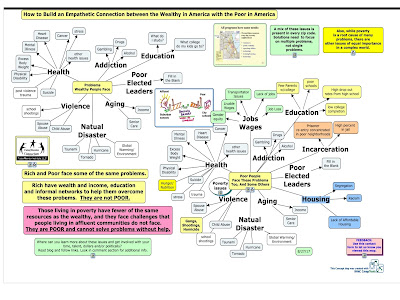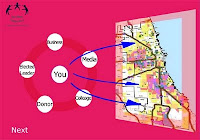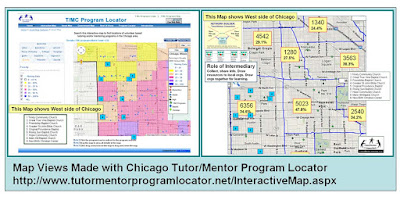I've supported that thinking since 1993 by building and maintaining a list of Chicago area non school, volunteer-based tutor and mentoring programs. Visit this cMap and you can find links to my list of programs, and platforms managed by others which you can also use to find youth programs in Chicago and other cities.
I started the Tutor/Mentor Connection in Chicago in 1993 with the goal of helping every neighborhood have great non-school programs reaching kids starting as early as 1st grade and staying connected to them all the way through high school, college and into work. The map graphic at the right illustrates that every program has common needs, that need to be met annually, for programs to operate, grow and improve.
One of the unmet goals of my work is to create a map platform where icons on the map indicate where donations of time, talent and dollars are landing in different neighborhoods. Without an accountability tool like this we'll never know for certain if were providing support to all the places where it's most needed.
Over the past 15-20 year's I've seen a growing number of high profile grant competitions, from the federal and state government, from foundations, and from business. In most cases many organizations spent countless hours of staff time, consultant fees, and emotional energy preparing submissions for these grants.
But the reality is that only a few programs win, and they many not win every year.
I first created this "good to great" graphic in mid-2000s and have used it often. Here's most recent article, from 2017.
In these articles I'm pointing to the Jim Collins booktitled "Good to Great and the Social Sectors"
To be great you need to build strong organizations, and that requires an on-going flow of resources.
Grant competitions with only a few winners don't fill a map of Chicago or any other city with great youth serving programs in every high poverty neighborhoods.
That's got to change.
Here's how that might happen. I created this map graphic a few years ago after reading the annual Forbes article about the world's richest people. The local Chicago papers featured this story again this past week, showing 17 super wealthy people living in the Chicago region.
I wrote articles suggesting that these people adopt different sections of the city and provide on-going operating dollars to support needed non profit and social enterprise organizations in their adopted areas. (see article)
Three of these guys are asking to be governor of Illinois. None has a visible track record of using their personal wealth to fund multiple programs as I've suggested, or to influence other wealthy people to join them. I'm sure they each can point to individual programs they've supported.
Funding youth tutor/mentor programs on an on-going basis, and helping new ones form where more are needed would be a great start, and could be happening in every city. However, as the graphic below shows, there are many challenges that need to be addressed, in every high poverty neighborhood.
All, or most, of these need to be addressed or we'll continue to spend tons of money with too little impact.
 |
| View this Race-Poverty map |
Those wealthy leaders who adopt neighborhoods could also adopt and fund the intermediary organizations who build the information libraries that are needed to support this effort. When I say "Information Library" I'm pointing to the Tutor/Mentor web library as an example.
This includes many articles showing uses of maps to help understand "who" is in the community who need to be at the table in efforts to create greater opportunities for all youth growing up in those communities.
These maps are among many that can be found on this blog (see maps tag) and on the Mappingforjustice blog. There's also a map gallery, showing maps created between 2008 and 2011, with links to blog articles that show how the map was integrated into a story.
Without building this information base, and the map resources, too few of those who need to be funded will receive consistent funds to enable them to constantly learn from their own work, and from others, and grow from year-to-year. Too few of those with roots in a community area will have a voice at the face-to-face or virtual on-line table.
Grant competitions will never solve this problem. They may raise visibility for the donor, and even the issue, but they do as much to harm organizations who constantly seek to win, but most often lose.
This is not like the business world, where one soap producer can distribute soap to people all over the city (if there are distribution points available). We need great youth tutor/mentor and family support programs in every high poverty neighborhood.
One more map!
This cMap is just one more way of showing that kids need many different supports as they move through school and into adult lives. Such supports need to be available in every high poverty neighborhood, just as they are naturally available in most affluent neighborhoods.
Adults who get involved as volunteer tutors, mentors, tech support, board members, etc. can help make this happen. Billionaires can provide the fuel.
Adults who get involved as volunteer tutors, mentors, tech support, board members, etc. can help make this happen. Billionaires can provide the fuel.
Competitions don't work.
Visit this section of the Tutor/Mentor web library to read about challenges facing non-profit organizations, such as this article titled "The NonProfit Starvation Cycle".
Like what I'm writing about? I'm starving for funds, too. Click here and use the PayPal button to support my efforts.














No comments:
Post a Comment